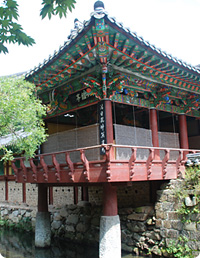PACKAGE
Self-Guide Korea 14 days
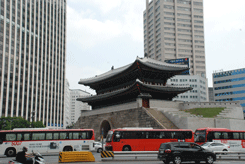
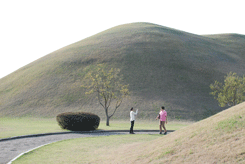
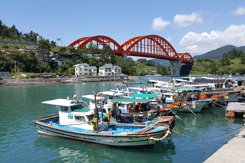
Tour Highlights
- Unification Observatory
- DMZ Museum
- Seoraksan National Park
- Hwanseongul Cave
- Sosuseowon Confucian Academy
- Ginseng Market
- Hahoemaeul Village
- Haeinsa Temple
- Goryeong Tumuli Museum
- Daegaya Museum
- Seokguram Grotto
- Bulguksa Temple
- Gyeongju National Museum
- Donggung palace and Wolji pond
- Banwolseong Fortress
- Cheomseongdae Astronomical Observatory
- Tumuli Park
- Gameunsa Pagodas
- Tomb of King Munmu
- Tongdosa temple
- Haeundae Beach
- UN Memorial Cemetery
- Yongdusan Park
- Jagalchi Fish Market
- POW Camp
- Lacquerware Museum
- Jungang Market
- Dongpirang Mural Village
- Jinju Fortress
- Hwagae Market
- Hwaeomsa temple
- Gwanghallu pavilion
- Gungnamji pond
- Jeongrimsa pagoda
- Buyeo national museum
- Busosan fortress
- Songsanri tombs
- Gongju national museum
- Oeammaeul Village
- Hwaseong fortress
The tour is designed for the group and unique in that tour guide is not accompanied other than the day of arrival pick up. The bus driver will then take you to the places specified, allowing you to explore the country at your own. The tour includes room and transfer only.
| Tour facts and features | |
| Accommodation | 13 hotel nights in 3 and 4 star twin share accommodation |
| Meals | Not included |
| Transport | All transportation by chartered private vehicle |
| Guide | Not included other than arrival pick up |
| Group size | 15 to 20 |
| Age range | 18+ |
Click on the days to access the programs quick
| Days | Visits and Activities | Distance |
| Day 1 | Arrive Seoul | 60km |
| Day 2 | Seoul | |
| Day 3 | Seoul - Goseong - Seorkaksan | 310km |
| Day 4 | Seoraksan | |
| Day 5 | Seoraksan - Samcheok - Punggi - Andong | 340km |
| Day 6 | Andong - Gayasan - Goryeong - Gyeongju | 340km |
| Day 7 | Gyeongju | |
| Day 8 | Gyeongju - Gampo - Yangsan - Busan | 150km |
| Day 9 | Busan | |
| Day 10 | Busan - Geoje - Tongyeong - Jinju - Hadong - Gurye - Namwon | 260km |
| Day 11 | Namwon - Jeonju - Buyeo | 140km |
| Day 12 | Buyeo - Gongju - Asan - Suwon - Seoul | 210km |
| Day 13 | Seoul | |
| Day 14 | Departure | 60km |
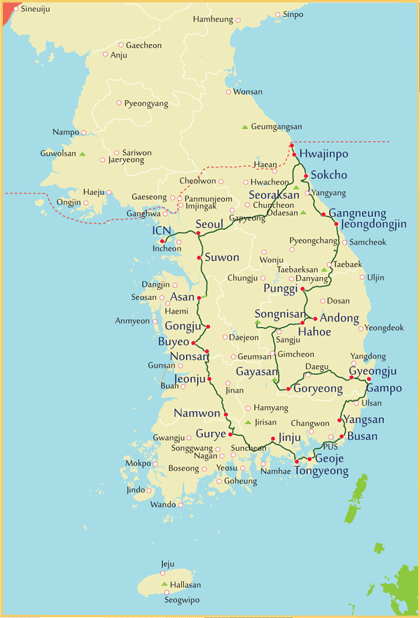 Day 1 Arrive Seoul (- - -) 60km
Day 1 Arrive Seoul (- - -) 60km
Touching down at Incheon International Airport places you in the heart of Korea. After you clear Passport and Customs control, you will be welcomed by the tour guide and then transferred to your hotel.
Day 2 Seoul (- - -)
Day at your own pursuit.
You can explore the city yourself.
Day 3 Seoul - Goseong - Seorkaksan (- - -) 290km
Your driver greets you in your hotel lobby and takes you on an excursion to Seoraksan national park. As you make your way to the east coast, enjoy the picturesque countryside, tranquil nature and beautiful landscape. At the northern tip of the east coast sits Unification Observatory. With the entry permit and sign to place in the vehicle window ready, continue towards the north, driving past lots of tank traps comprising large lumps of concrete set on either side of the road, all a strange and eerie reminder of the tensions that exist between the two Koreas and the stark reality of the divided country. While there, you will get a glimpse of the much talked about border dividing the two Koreas and see the road and train track stretched side by side ahead across the North Korea.
Stop at DMZ museum offering very surreal experience of a lifetime. In the hopes of bringing peace to the country from the painful past, the museum presents the South Korean side of the conflict with the North, underscoring the historical significance of the DMZ and embracing everything about the latest efforts made to transform the DMZ from a place of political scars to a symbol of peace and ecology.
Enjoy a short tour of Socho, once a sleepy fishing village that turned into the heart of Korea's most spectacular recreational areas. In downtown, there is a colorful market selling fishes, fruits, vegetables, grains and daily necessities, and a little further down is a North Korean refugee village that can be accessible by a hand-pulled boat. At Daepohang, you will see a wide variety of fresh seafood harvested from the nearby sea and a number of small restaurants serving sliced raw fish. You will find something to enjoy, from simply feeling the ambiance of this small fishing port to taking picture.
Seoraksan national park is a place that you can definitely find lots of outdoor activities to make it worthwhile for an extended stay. The dense forests bordering crystal clear streams which tumble over cataracts and drop from precipices to form white waterfalls, as well as awesome saw tooth cliffs spiraling into the blue skies, and scenic valleys altogether make this park and surrounding area some of the most beautiful sceneries on the Korean peninsula, and give this area an unparalleled popularity around the year.
Day 4 Seoraksan (- - -)
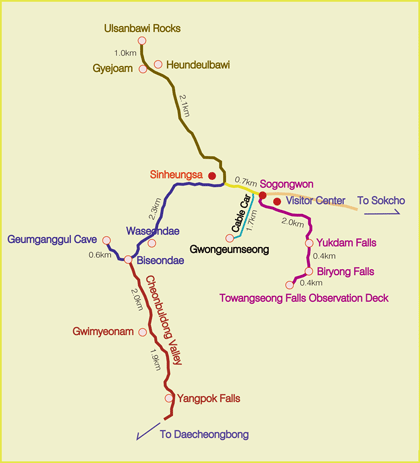 The word of the day is hiking of varying lengths and difficulty. All route types are out and back. Today, you will form your own independent tour to explore Seoraksan national park that has many different trails, and you are free to pick and choose which ones you want to do.
The word of the day is hiking of varying lengths and difficulty. All route types are out and back. Today, you will form your own independent tour to explore Seoraksan national park that has many different trails, and you are free to pick and choose which ones you want to do.
Only a small walk from the park entrance (Sogongwon), you will marvel at a large bronze statue, Unification Buddha, symbolizing Korean people's hope for reunification of the country. A little further on is Sinheungsa temple which claims to be the Korea's oldest Zen temple. Left trail in the direction of the temple is a trailhead of Cheonbuldong valley, the most impressive valley in the park, leading finally to the Daecheongbong peak of Seoraksan (1,708m), while right trail is up to Ulsan Bawi Rocks.
Among the most recommendable trails from Sogongwon are as follow and the given times below are based on round trip in a bit relaxed pace.


Cheonbuldong valley Trail
One hears many legends of the heavenly nymphs who come down to play at Biseondae while taking a bathe in the placid pools of the valleys that are hidden from the human eyes. Near Biseondae rises Janggunbong majestically and among the crags of it is a temple alcove, Geumgang cave. You may want to head up a very steep incline for 600m from the gentle slope of the trail, and you can scale only by carefully ascending the long, steep, metal stairs bolted onto the sheer cliff face. The hike, although hard, comes with a stunning view of numerous cliffy peaks and mountain valley. From Biseondae, another 3.5km to Yangpok Falls, so spacious yet everywhere you looked you are surrounded by giant mountain peaks.

Ulsanbawi Rocks Trail
About an hour and half into the walk from the park entrance is Gyejoam hermitage. Located at the base of Ulsanbawi, and the point at which the trail takes a sharp rise upwards. In front of the hermitage on a spacious stone slab is a huge spherical rock called Heundeulbawi. This rock is soperfectly balanced that it can be shaken with some effort, but nobody gets further than waggling it. Your adventure begins by climbing a massive steep staircase that winds its way up the side of the cliff that angle up Ulsanbawi which is in a folding screen shape made up of cliffs on all sides. It is a 1.8km-long ridge of naked, gray stone peaks jutting well over 800m into the sky.

Biryong waterfall Trail
The trail is relatively easy for anyone to try and you will view Biryeong waterfalls at the trail end. About 400m further above the falls, you will be amazed at Towangseong waterfalls cascading down a 320-meter cliff.
Cable Car
There is a cable car that picks you up at the valley floor to the Gwongeumseong. The peak is surrounded by cavernous drop-off cliffs, cloaked in more towering rocky summits. Definitely, you stand in awe on the top: sweeping panoramic views of the park around you, the Pacific Ocean, and the small beachside town of Sokcho. Be careful as always as there is not much room to move about and people constantly going up and down and moving around.
Hiking Trails
1. Biryong Falls (4.8km): 2 hours - Walking on a trail and suitable for whole family
2. Biryong Falls + Towangseong Falls Observation Deck (5.6km): 3 hours 30 minutes - Serious hiking from Biryong Falls to the observation deck
3. Biseondae (6km): 3 hours - Walking on a trail and suitable for whole family
4. Biseondae + Geumgang cave (7.2km): 4 hours 30 minutes - Very strenuous hiking from Biseondae to the cave
5. Biseondae + Yangpok (13.8km): 7 hours - Walking on a trail and no use of hands
6. Heundeulbawi (5.6km): 3 hours - Walking on a trail and no use of hands.
7. Heundeulbawi + Ulsanbawi (7.6km): 5 hours 30 minutes - Very strenuous hiking from Heundeulbawi
8. Gwongeumseong Cable car (3.4km): 1 hour (roughly four minutes each up and down)
Day 5 Seoraksan - Samcheok - Punggi - Andong (- - -) 340km
Depart Seoraksan early this morning to arrive in Andong, a stronghold of Confucianism that has deeply influenced the lives of Koreans in all aspects. Explore Hwanseongul Cave. About 6 minute on a mono rail gets you to a cave entrance of overwhelming size in the middle of the mountain. The cave itself is super massive and it would take well over one hour to explore. Be prepared for wet walkways, maneuvered up a narrow corridor with a rapidly flowing creek below it and hung off the side of the cave's walls above the creek. Many waterfalls are actively eroding the floor. Only 1.6km open to the public; yet that section alone will provide unforgettable memories. Cave tour is absolutely at your choice. You could opt out by staying outside, or simply relax.
Sosuseowon from the 16th century is the first private institute established in Korea. It was a birthplace of Confucian education and a cradle of prominent scholars. The compound itself is composed of two sections; academic studies and research, and memorial service. There are several old buildings where scholars learned and studied loyalty, filial piety, manners and knowledge. Although the educational function of the facility has long since ceased, the commemorative ceremonies have been and are still held twice a year.
While in Punggi, a small remote town famous for quality apples and ginseng, you will explore ginseng market with piles of fresh ginseng roots, including variety array of ginseng products. This mysterious root, which has a good smell better than it tastes, has historically been considered an empowering medicine and a cure-all. Street vendors sell flowers, fruits, food stuff and home grown grains and vegetables. With all these features combined creates a rural ambience of Korea's remote town.
Time permitting, visit Jebiwon Buddha or Ichon-dong Stone Buddha. The awe-inspiring Buddha statue stands guard over the northern entrance way to Andong for nearly 1000 years. It's a relief-carving of the body on a sheer boulder-side, under a 3D-carved head made from a natural stone found on top of that cliff.
Day 6 Andong - Gayasan - Goryeong - Gyeongju (- - -) 340km
Spend another day of heavy schedule by enjoying the landscape of farming communities charming cities, magnificient temple and museum as you make your way to Gyeongju. Visit UNESCO World Heritage Site, Hahoemaeul from the 15th century. It is the best preserved traditional village portraying and spanning the life of the Joseon Dynasty (1392-1910) and some 480 Korean traditional houses, both large and small, are still fully functioning. As you take a walk in the narrow alleys, enjoy the rustic and old charm of this unique village. You cannot possibly miss a 600-years old zelkova tree, the home to the village spirit. At the tree's base is where residents still make their wishes. The village is also known for traditional festival, Hahoe Mask Dance which gave common people the opportunity to mock those in authority, and in particular the Byeolsingut, a shaman ritual exorcising evil spirits, dating back to the Goryeo dynasty (918-1392).
Journey continues to the 9th century Haeinsa. Renounce each of 108 worldly desires of the mind as you climb 108 stairs. Within the Hall of Great Peace and Light, you will see Vairocana Buddha attended by Bodhisattvas and highly detailed and rather unusual wall paintings of the Buddha's life. And on the outside walls are a fair number of paintings portraying Buddhist stories. At the back of this hall is a group of four depositories or Janggyeong Panjeon from the 15th century. Housed within the depositories are 81,258 wood-blocks of Tripitaka Koreana, the world's oldest and a complete collection of the Buddhist sutras as well as an offering to the Buddha for national protection from the looming Mongol forces. The printing blocks are some 70cm wide, 24cm long and 2.8cm thick on the average. Each block has 23 lines of text, each with 14 characters, on each side. Each block thus has a total of 644 characters on both sides. Some 30 men carved the total of 52,382,960 characters in the clean and simple style. The characters are perfectly carved as if from the same hand. They were completed in 1251 after 16 years of work on Ganghwado and were transported here for safekeeping. The Mongol forces eventually took over the Goryeo Dynasty but the wooden blocks remain preserved today having survived other invasions, wars and fire. Even more amazing aspect is that neither birds built nests nor spiders make webs on these buildings. Check out two long depositories are designed to have natural ventilation by facing different size windows in the front and rear of the building. Tripitaka Koreana and Janggyeong Panjeon have been designated by UNESCO as a World Heritage for their artistic as well as religious value. In order to control the temperature and humidity within the depositories and protect the Janggyeon Panjeon and woodblocks from fire, full-time security guards and a 24-hour surveillance system are in place.
Visit Goryeong Tumuli Museum featuring a perfect replica of the Jisan-dong Tomb No. 44 itself and learn about the ancient sacrificial burial custom a funerary practice. About 40 persons were presumably entombed together. Such examples of massive human sacrifice have not been found in other ancient tombs of the era of the Three Kingdoms. Visit also includes Daegaya Museum exhibiting a huge collection of artifacts excavated in Goryeong.
The journey continues to Gyeongju, an ancient capital of Silla (BC57-AD935) often dubbed as Museum without Walls. Today, you are treated to one of the ten most historically significant sites in the world with ancient temples, weathered stone pagodas, royal tombs, Buddhist bas-reliefs, and fortress ruins.
Day 7 Gyeongju (- - -)
With a full day to explore the delights of UNESCO World Heritage Site, Seokguram grotto. It is the home of the serene stone Buddha of the eighth century. Inside, a white statue of a seated Buddha in a sublime state of enlightenment, is surrounded by 37 relief figures of Bodhisattvas, disciples, devas, and guardian kings. The grotto represents the magnificent harmony of religion, science and the arts of Buddhism, symbolizing the pure land in which Buddha resides.
A short ride leads you to another UNESCO World Heritage Site, Bulguksa temple, where you will witness the impressive gates, symbolic bridges leading up to the world of Buddha, graceful architectures, Three-storied Seokgatap and highly ornate Dabotap blending well into the architectural harmony.
At Gwaneumjeon hall, check out the image of the Avalokitesvara who is referred to as the Bodhisattva of Compassion and has a thousand hands, and eyes in each so as to reach out to those in need of help. You will see a gilded statue of Vairocana with the gesture of the first wisdom, Sakyamuni Buddha along with sixteen figures of Buddha's disciples sitting in deep meditation, and a gilt-bronze Amitabha Buddha who is the ruler of the Western Paradise Sukhavati. The architectural design of Bulguksa is one of constrained dignity, peace, and harmony and the temple still remains one of the most remarkable achievements of the ancient Far East.
The Gyeongju Historic Areas contain a remarkable concentration of outstanding examples of Korean Buddhist art, in the form of sculptures, reliefs, pagodas, and the remains of temples and palaces from the flowering, in particular between the 7th and 10th centuries, of this form of unique artistic expression.
The driver will drop you off at Gyeongju national museum and later pick you up at Gyeongju station, allowing you to explore highlights at your own pace. The first thing that you will notice in the museum is The Bell of King Seongdeok, the largest extant bell in Korea. You must certainly stand in awe before the bell from the 8th century with such artistic beauty of design. The bell is distinguished not only for its outstanding beauty but also for its long reverberating sound, the incredibly precise casting technique, in addition to the sad legend surrounding it. On entering the museum, you will marvel at the priceless archaeological and historical artifacts including splendid gold crowns, earrings, belts, ornaments, glassware, potteries, and clay figures as well as a royal barge.
With time to visit, you will enjoy a walking tour covering Donggung palace and Wolji pond, a pleasure garden built to commemorate the victory of Silla, and later used as the recreational area for the Silla's royal family, the ruins of Banwolseong or half moon fortress where Silla palace and eight fortress gates stood. There is a Seokbinggo, a freezer made of stones. Half of the structure is underground while the other half is above ground with three air vents on top. You can feel the cold oozing out of this simple structure. Near fortress is Gyerim, literally meaning Rooster Forest. It is a sacred woodland area where progenitor of the Gyeongju Kim family, Kim Alji, was supposed to have been born.
You also witness the world's oldest existing astronomical observatory, Cheomseongdae. Each stone used in the observatory bears symbolic meaning; the same number of the days of the year by lunar calendar, the number of the major stars, the months of the year and the numbers of the seasonal divisions. Nearby Tumuli Park encompasses 23 huge tomb mounds where Silla rulers were buried. One of the tombs, Cheonmachong, is opened to the public and you can go inside and see how the tombs were made and replicas of the treasures excavated in 1973.
While in city center area, you may want to explore criss-corss downtown alleys, a fascinating Seongdong market or vibrant Jungang market housing all kind of vendors selling anything you would ever need.
Then, meet the bus in front of Gyeongju station for your return transfer to your hotel.
Day 8 Gyeongju - Gampo - Yangsan - Busan (- - -) 150km
Depart Gyeongju for a 30km drive and en-route, stop at Gampo to see Gameunsa Twin Pagodas. These immense pagodas have a three-story body on a two-tier foundation. Stair step effects are seen under the eaves of the roof while the roof line has a gentle slope and is comparatively broad-brimmed. You will marvel at these true masterpieces of Korean architecture.
A short ride from the ancient temple site of Gameunsa dedicated to the Dragon Spirit of King Munmu (626-681) is an unusual Underwater Tomb of King Munmu, about 200m off the coast. The king wished his body to be cremated and buried at sea so he could protect his kingdom even after his death as a spirit of the sea. In the center of the calm sea a large rock marks the site. About 20m long rocky islet has a small pond at the center and at the bottom is a granite stone of 3.6m long, 2.9m wide and 0.9m high. At low tide, the top of this oval rock is almost visible above the sea surface.
En route stop at the 7th century Tongdosa temple, representing the Temple of the Buddha. The approach to the temple is completely entrancing. Magnificently set by a lane of pine trees dancing in the wind and beside which a mountain stream sings a babbling song, a distinctive and exalting place. The main worship hall is unique in that it does not contain a statue of the Buddha, but rather a window looking out onto the Diamond Precepts Altar with a bell-shaped stupa that contains the cremated remains of the Buddha himself. You will find the temple more like a museum as it houses many local treasures and cultural properties.
Continue to Busan, Korea's second largest city surrounded by the ocean on one side, and mountains on the other. Its deep harbor and gentle tides have allowed it to grow into the largest port in Korea and the fifth largest in the world. It is also a center of industry and commerce, a thriving metropolis formed unusually long in shape along its coastal line.
Enjoy a short break at Haeundae, a world-class beach resort blessed by beautiful water and screened by skyscrapers along the beautifully curved coastline. Afterward, cross the Suyeong Bay over Gwangan Bridge, installed with over 10,000 colorful LED lights which sparkle brightly under the night skies.
Visit UN memorial cemetery where 2,300 deceased soldiers from sixteen Korean War allies rest in honored serenity. Learn about the Korean War and pay tribute to those who dedicated their lives to the World Peace. During the period of 1951-1954, remains of approximately 11,000 fallen of the UN Forces were buried here. Thereafter, most were repatriated to their home countries. In the cemetery, lie the remains of Korean War heroes from Australia(281), Canada(378), France(44), the Netherlands(117), New Zealand(34), Norway(1), South Africa(11), Turkey(462), the United Kingdom(885), the United States(36) and Republic of Korea(36) as well as of unknown allied soldiers(4) and non belligerents(11).
You will tour Yongdusan Park where Busan Tower sits atop a hillock of a steep slope, affording 360-degree views of the hilly terrain of this mountainous coastal city and the harbor. Smack dab in the middle of the park stands the statue of Yi Sunsin, who is credited with the perfection of the first iron-clad warship in history. You will also see a flower clock and a Busan citizen's bell that they ring on New Years' Day, March 1 and August 15.
Just off the park is Gwangbokro Street, full of shops selling everything from bargains to luxury items. Adjacent is a maze of small streets alive with color, sidewalks sprinkled with unique shops and local eateries. Enjoy the vibrant ambience as you leisurely make your way to the BIFF square, Busan’s modern movie district having hand prints of the famous movie stars and directors on the sidewalk, movie theaters, trendy shops and street food stalls. The area with originally little more than a pair of cinemas that were built over half a century ago had turned into the newly transformed district, and was named BIFF Square on August 14, 1996.
Across the street from the square is a fascinating Jagalchi fish market, a great attraction located dockside. Here you will find a diverse array of seafood on display as you walk along the narrow alleys of street vendors. A nearby indoor market features live fish in the tanks and the upstairs are dried fish along with many restaurants selling raw fish at reasonable prices. The market is really a visual and culinary treat.
Day 9 Busan (- - -)
Day at your own pursuit. You can explore the city yourself or simply relax.
Day 10 Busan - Geoje - Tongyeong - Jinju - Gurye - Namwon (- - -) 260km
Today, you will experience the deepest highway on earth, Geoga bridge, a 8.2km-long bridge which is a combination of two cable-stayed bridges built on the open sea, a number of approach bridges and tunnels built on three islands in the middle and a 3.7km-long immersed tube constructed 48m below mean water level.
Geoje is a shipbuilding Mecca featuring several natural harbors. And once was the final port of call of the SS Meredith Victory at Christmas 1950. It is best known for evacuating more than 14,000 refugees in a single mission in the largest humanitarian rescue operation by a single ship during the Korean War.
There’s time to visit the POW Camp which at one time held around 170,000 prisoners in 28 facilities until an armistice was concluded in 1953. The former camp has been reborn as a historic park with various exhibition halls that help visitors comprehend the actual situation at the time and gives visitors an up close lesson on the devastating consequences of the war. POW camp accommodated 150,000 North Korean soldiers and 20,000 Chinese soldiers.
Tongyeong is a traditional seaport of great charm and historical interests. Visit Lacquerware Museum and admire the sophisticated craftsmanship and nacre Lacquerwares that have long been sought after by collectors and aficionados worldwide. Next up is Dongpirang village where you will enjoy witty and delightful murals and sweeping view of Tongyeong harbor. This village was on the verge of being torn down, but what were once shabby houses now welcome visitors with radiant colors.
On a long stretch of quay-side is Jungang market, and you will witness a lively atmosphere as vendors try to make a deal. Rows of seafood restaurants and local eateries offer anything that comes from the ocean, the sights, sounds and smells of a fishing port. At the nearby Gangguan port, you may want to step in to the replica turtle ship from the 16th century.
Jinju is a charming city set by the picturesque Namgag river. Explore Jinju fortress where a faithful girl Nongae plunged into the swirling river holding a Japanese general tightly in her arms, drowning both when Japanese troops breached the inner wall in the 16th century. You will tour the Jinju National Museum displaying historic artifacts and documents that speak to the Hideyoshi's invasion.
Hwagae Market offers a colorful bazaar of produce. The market is full of excitement. The cheerful rhythm of the drum attracts the ears and eyes of many, creating an exciting atmosphere. A traditional blacksmith still produces hoes, sickles, and other implements in the traditional ways. While here, you can feast your lips on local specialties.
The journey continues to Gurye for a visit to the 6th century Hwaeomsa. The whole atmosphere of the temple is sublime and the wooden structures give it a real earthly feel, very calming. The temple is dedicated to the vairocana Buddha, the cosmic head of the Hwaeom trinity. First, One-Pillar Gate standing at the lower part greets you and leads you up to the second and the third gate - from the secular world into the spiritual world. On the second level, there is the Bojeru, the Save All Beings Hall, beside which stands bell and drum tower. And on its ground stands two magnificent 5-story stone pagodas from Silla period that adorn the temple.
Gakhwangjeon has a double storied roof and houses seven figures on its altar. Sakyamuni Buddha sits in the middle attended by Amitabha and Prabhytaratna, as well as Avalokitesvara, Samantabhadra, Manjusri, and Ksitigarbha. You check out the largest stone lantern on the Korean peninsula that is designated National Treasure out in front of this hall. And up from the left of Gakwhangjeon hall, a steep set 108 uneven stairs on the hillside stands the Three-Story Stone Pagoda supported by four lions each of which represents the four primary human emotions: love, sorrow, anger and joy. Here, you will enjoy the intricacies of this masterpiece as there are numerous other designs etched onto the pagoda.
Depending on timing, you will have a great chance to witness Four Buddhist Instrument
Ceremony. The bell, which almost all Korean temples are equipped with, is one of the four Dharma instruments together with Dharma drum, wooden fish, and cloud-shaped gong. Hearing it reverberating through the universe, you will reflect upon the profound symbolism of the instruments. It is a great vow to save, or enlighten, the creatures in the universe including those on land, in the sea, in the air and in hell.
Day 11 Namwon - Jeonju - Buyeo (- - -) 140km
Namwon is a charming city with many historical sites and tourist attractions. It is also famous as the home of Chunhyang, the faithful maiden whose story has been often compared to the Romeo and Juliet. At the center of the town is a park, in which stands Gwanghallu pavilion where Chunhyang and her lover are said to have first met, and there is a bridge built on a pond that is supposed to ensure connubial bliss to any couple that steps on it.
Jeonju boasts a time-honored tradition as well as significant cultural and artistic heritage. There's a plenty of history and artifacts of many kinds to go around. Explore Jeonju Hankok village, a Korean House complex retaining much of their perfection intact. Near the entrance of the complex stands Gyeonggijeon that holds the portrait of founder king of Joseon dynasty, featuring him seated in a magnificent red chair with three gold-foiled dragons on his royal blue robes. And on its front is a beautiful Jeondong Catholic church of Byzantine and Romanesque architectural design. Completed in 1914, it is one of the oldest and largest Western-style buildings in the region. It was designed by master church builder Victor Lousi Poisnel, the Norman priest whose work in Korea includes Myeongdong Cathedral in Seoul. Just west of the church is the stately Pungnammun gate, where three Catholics paid for their religion with martyrdom on December 8, 1791, marking the first time in Korea.
Hat Museum offers a collection of handmade hats and a carefully chosen selection from among the most characteristic styles, providing a wide-angle cultural perspective on what has always been the essential accessory. Some 300 hats are on display ranging from traditional Korean hats such as the Gat, made from bamboo and horse hair, to the modern hunting cap and beret. While not particularly worth visiting on its own, a small traditional wine museum within features a decent exhibition of some traditional Korean alcohols and the processes that created them. Hanji Industry Support Center is a good source of learning traditional Korean paper gaining global recognition.
Buyeo is a melting pot of Baekje culture which is often regarded as the most artistically sophisticated of the Three Kingdoms. Today, you will explore archaeological sites and ancient historic areas, which were collectively named as a UNESCO World Heritage sites. Gungnamji is the Korea's oldest artificial pond dating back to 634. Ringed by weeping willow trees, it creates a colorful spectacle with its stock of water lotuses in summer. Jeongrimsa temple site with its five-storied stone pagoda recalling the glorious past is one of the city's most distinctive and outstanding landmarks.
At Buyeo National Museum, you will feel the spirit and the essence of the brilliant Baekje culture as you appreciate the beauty of the archaeological relics. A beautiful gilt bronze incense burner is impossible to miss. Crafted over 1,500 years ago, it shows a graceful dignity and the elaborate skills of Baekje craftsmen.
Stroll up paths to Busosan to explore Baekje fortification. At the top of the hill sits Yeongillu pavilion where the king once came to watch the sun rise over his kingdom.
A little further down the trail, you will see a pavilion called Baekhwajeong perched at the top of the rock beside which locates Nakhwaam, literally meaning Falling Flower Rock, on a bluff overlooking the Geum River at the bend called Baekma. As enemies swarmed into the capital, the court ladies flung themselves into the water from this bluff rather than suffer the shame of submitting to atrocities of the conquering enemy armies.
Day 12 Buyeo - Gongju - Asan - Suwon - Seoul (- - -) 210km
Gongju is a charming city that once served as the Baekje's capital for 63 years from 475 to 538. Visit Gongju National Museum and get a glimpse of the fascinating archaeological articles from Baekje (BC18-AD660) era, and artifacts excavated from the royal tomb of King Muryeong (501-524), one of the last rulers to reign in the capital of Gongju.
Near museum is UNESCO Heritage site of Songsanri Tombs, a group of royal tombs that just look like a cluster of grassy knolls. The tomb which belongs to King Muryeong (462-523) and his wife, the queen was found completely intact since it was sealed in the early 6th century. The actual tomb was permanently closed, but you will see an excellent, albeit miniature duplicate. Afterwards, drive to the ancient royal city of Buyeo, a melting pot of Baekje culture which is often regarded as the most artistically sophisticated of the Three Kingdoms.
Oeammaeul is one of the traditional clan villages exuding old and rustic charm. The village entrance is marked by stone bridge, pine forest and totem poles. This village with more than 400 years of history has about 70 traditional houses, and is highlighted by 6km-long stonewall paths ringing the village and the amazing artificial water system that goes through the entire village for gardens and agriculture. As you stroll along the pathway, you will see thatched cottages and tile roof houses representing typical village layout of central Korea and at the same time feel the rural ambience and peaceful atmosphere.
En route, stop at Suwon to explore UNESCO World Heritage site of Hwaseong Fortress from the 18th century. Though it is relatively small in scale, it is well acknowledged as the best structure of its kind ever built in Korea. A 5.74km-long fortress enclosing both flatland and hilly terrain is parapeted with crenels and merlons and highlighted by four main gates and well over 50 structures including temporary palace where the king sought refuge during war and found rest during times of peace. A walk through the whole fortress could take several hours but it is well worth making a short walking tour to enjoy the splendor of the fortress, including the Korea's largest Janganmun Gate.
Day 13 Seoul (- - -)
Day at your own pursuit. You'll have plenty of opportunity to explore the city at your own .
Day 14 Departure (- - -) 60km
After this wonderful trip exploring Korea and with time to reflect on your surprise in your experience, you will return to Incheon International airport in time for your flight. By boarding, you are already high above Incheon heading for home.





